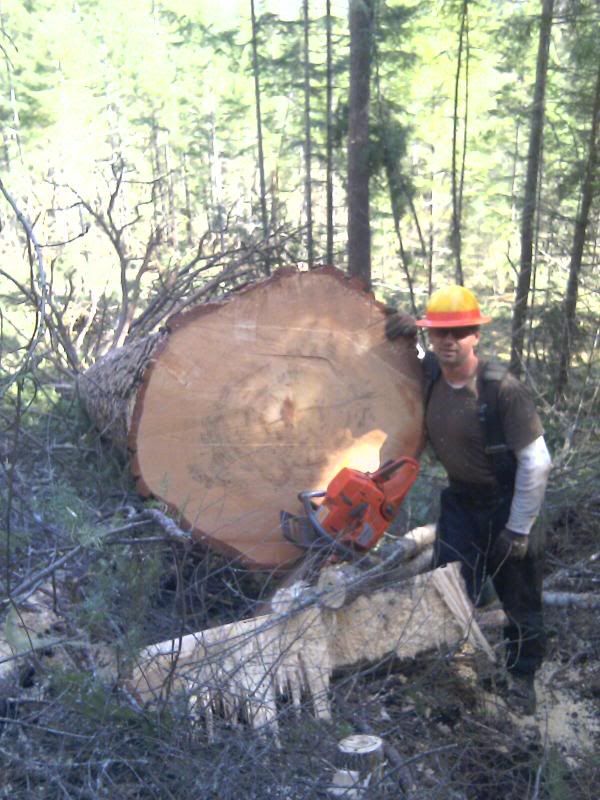Burvol
Bullbuck
Kiss my Ass East Coasties, LOL











49-50 on the butt, saved out 3 32's, and a nice 26. Had 4 32's but I powerbucked it in the bottom of this nasty little hill. I am quiet pleased how it went into the lay. There was an RMZ that it could have went into had it broke off. I left 4 inches of wood on my side, gutted the heart, and raised the backcut about 6-7 inches. I had a 15" double taper and 8 redheads in it. I was starting to sweat the wind change I had. I did not have my jacks in my truck yesterday. I worked it up and waited for the wind to change. I was BSing with the side rode when it tipped and went down, it was cool. I"m gonna buck it today. This was almost after hours yesterday and I'll have my long bar today. I'm guessing around 8 bushel save out. This thing is a pipe. It almost appears to get bigger as I walk it out. The pictures are disapointing.Thing is way bigger walking it.
I have been doing unit layout. The way we cram a bit more volume into a skidder unit is to run it up a steep slope not quite a tree length, and plan that "the fallers can launch it down to the skid trail." I've not heard any whining about that. How hard is that for you guys to do? The diameter runs from 10 to 16 inches and they are thinning units. West WA doug and hemlock, probably average 120 feet tall to the tippy top.
10 to 16 inches? Shouldn't be a problem.
Ok so I gotta ask what is a pumpkin and what does it mean when you talk about bushels?
Ok so I gotta ask what is a pumpkin and what does it mean when you talk about bushels?

I thought that a bushel was 1000 board ft Scribner.:monkey:1 US bushel = 14.933473 board feet
board foot (bd ft, fbm, or BF)
a unit of volume used for measuring lumber. One board foot is the volume of a one-foot length of a "standard board" twelve inches wide by one inch thick. Thus a board foot equals 144 cubic inches, or 1/12 of a cubic foot, or approximately 2.360 liters. The number of board feet is easily computed from the dimensions of the stack, no matter how wide or thick the boards are. For example, a stack of two-by-fours 4 ft high, 4 ft wide, and 8 ft long contains 4 x 4 x 8 = 128 cubic feet, equivalent to 128 x 12 = 1536 board feet. The symbol fbm is an abbreviation for "foot, board measure."
bushel (bu) [1]
a traditional unit of volume used for measuring dry commodities such as grains and fruits. In the United States, the customary bushel is based on an old British unit known as the Winchester bushel. This unit dates to the early fourteenth century, at least: King Edward I defined the bushel to be 8 gallons in 1303. The form used in the U.S. was legalized by Parliament in 1696. One U.S. or Winchester bushel equals 4 pecks or 32 (dry) quarts; this is a volume of 2150.42 cubic inches or about 1.2445 cubic feet, and represents the volume of a cylindrical container 18.5 inches (47.0 cm) in diameter and 8 inches (20.3 cm) deep. The U.S. bushel holds about 35.239 07 liters. Traditionally, there is also a heaped bushel, which is 27.8% (sometimes 25%) larger than a regular bushel. The regular bushel is also called struck measure to indicate that the bushels have been struck, or leveled, rather then heaped. The origin of the word "bushel" is unclear; some scholars believe it derives from an ancient Celtic unit, but most believe it is of medieval French origin, probably a slang name for a wooden crate (the French word for wood is bois).
bushel (bu) [2]
a unit of volume in the British Imperial system (see gallon [3]) equal to 8 Imperial gallons, or 2219.36 cubic inches (1.2844 cubic feet). The Imperial bushel holds about 36.369 liters.
bushel (bu) [3]
a commercial unit of weight for grains and other bulk commodities. Agricultural commodities such as wheat are traditionally sold by the bushel, but because commodities tend to settle and compact in shipping, disputes over the volume delivered arise easily. To avoid these disputes, traders in a market or a country generally agree on a standard weight for one bushel of the commodity. Often this standard weight is set by law. Although the bill of lading still shows "bushels," it is really the weight rather than the volume that is sold and guaranteed. For example, in the United States a bushel of wheat equals 60 pounds (27.216 kg), a bushel of barley 48 pounds (21.772 kg), a bushel of oats 32 pounds (14.515 kg), and a bushel of rye 56 pounds (25.401 kg). A more complete table is included.

Enter your email address to join: